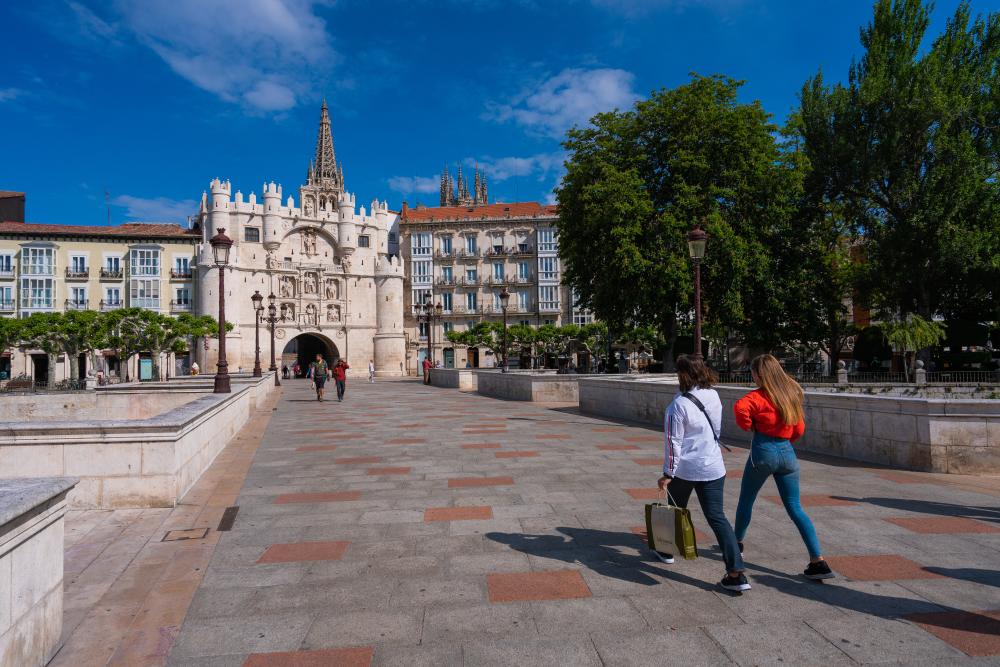From Plaza Del Cid this route starts alongside the Espolón promenade, work of the XVIII century that marks the enlargement of the city beyond the walls and it will change the outskirts of the walls onto a big promenade surrounded by gardens next to the edges of the Arlanzón river. In this promenade the entrance arches to the Main Squadre reminds us the old sketch of the walls. The previously called “puerta de carretas” used to give access to the square of the minor market, that today is the main squadre of the city. Another curiosities we find in the Espolón are the statues of the royal palace in Madrid that King Charles III gave to the city, and another ones neoclassical style, gift of the queen Elizabeth II.
In the promenade is located the sea consulate, building of the XVII century that reminds the old commercial past of Burgos, that represented the main boost of the trade and financial development of the city, because it was from where during the ages of the Catholic Kings the commerce of exports of the wool of the castillian sheeps.
A little forward, the visitor finds himself in front of the most important entrance gate of the city through the walls, the gate of Santa María, whose actual design date from the second third of the XVI century. In the year 1536 the councilors of the city council requested its remodelling to the architects Juan de Vallejo and Francisco de Colonia. Its importance grew since 1600, when it become the official entrance gate of the monarchs who were visiting the city and where they had to swear respect to the regional codes of the city.
4-SURROUNDINGS OF THE WALLS
We continue this route thought the paseo de la Audiencia, the extension of the Espolón. In the first turning street, Eduardo Martínez del Campo, its erected a complex of remarkable buildings of the XIX and XX centuries. The archbishop palace stands out, neo-Reinassance and barroque inspired by the popular syle-mixture at the end of XIX century and the church of the Salesas, in front of which, just a few meters away, is located part of the original wall that dates from Alfonso X “El sabio” times.

5. PASEO DE LOS CUBOS AND “DOÑA LAMBRA” TOWER
The visitor will get into the Paseo de los Cubos, where it is found the largest pìece of the walls preserved at present. In this wall is located the gate that leads to the old jewish quarter, next to “Doña Lambra” tower, where the local synagogue, one of the most importants back in XIII century, was communicated with the outskirts of the city.
Just before accesing the fortress, the main attraction of this route, we have to pass one of the main gates of the jewish quarter, Saint Martin’s arch. Mudejar-style made, is the gate located on the east of the precinct of the walls, from where the kings entered the city after swearing respect to the local codes of the city and from where the pilgrims on their route to Santiago used lo left Burgos.
Crossing the gate there is the Site of El Cid, where according to the popular tradition used to be the house of El Cid Campeador. Behind it there is the hill that leads to the castle, that can be reached following some stairs that will lead the visitor to the viewpoint of the castle, from where an spectacular view of the old fortified precinct and all the city centre can be enjoyed.. The castle date back to the year 884, when count Diego Porcelos founded the fortress and the city by command of the king Alfonso III.
8. SAINT ESTABAN’S AND SAINT GIL’S ARCHES
Now we leave the castle following an stair that goes down parallel to the wall and leads to the mudejar-style arch of Saint Esteban, from the XIV century, composed by a double horseshoe arch and two square-shaped towers with a gallery with six round arches between them. On our way down to the next gate, San Gil’s arch, we can observe remainders of the old walls.
9. PALACIO DE CAPITANÍA AND SAINT JOHN’S ARCH
We shall continue our route following Avellanos street to arrive to the old time called “gate of Margarita, where now raises the neogothic building of 1903 that hosts the general military captaincy headquarters. This route finishes once we reach Plaza España crossing thought the eastern gate of the walls, Saint John’s arch, from where the pilgrims used to enter the city, reconstructed in 1563 by the architects Simón de Bueras and Martín Ochoa de Arteaga.



